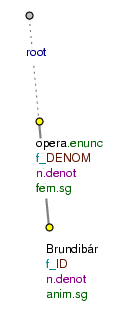- Definition of the functor
ID -
The functor
ID(identity) is used as a functor for the effective root of an identifying expression, which is represented as an identification structure.
For the definition of identifying expressions and their annotation rules see Section 8, "Identifying expressions".
The functor ID is assigned to adnominal adjuncts representing meta-language expressions, proper nouns and names of animals, objects and events - they have the form of the nominative of identity (see Section 8.1, "Basic rules for the annotation of identifying expressions") or the so-called explicative genitive (see Section 8.1, "Basic rules for the annotation of identifying expressions").
Valency. The ID modification is always a non-valency modification.
Forms. The basic forms of modifications with the functor ID are:
-
noun in a non-prepositional case form.
The most common forms:
nominative v případu Kott - Kutílek (= in the case Kott-Kutílek); agentura Reuter (=Reuter agency); pojem čas (=notion of time) genitive osoba Václava Klause (=lit. person (of) Václav Klaus); trest odnětí svobody (=lit. sentence (of) - prison); pojem času (=notion of time) Example:
opera Brundibár.
ID(= opera Brundibár) Fig. 7.57
NB! Identifying expressions (ID) can take any form.
Examples:
nápis Obětem.ID války (=the sign "To the victims of war")
skladba Svatý Václave.ID (=lit. piece Saint Wenceslas!)
povídka Opatrně.ID (=the short story Carefully)
Řekl to v úterý v pořadu Proč.ID (=he said it on Sunday in the programme "Why")
v pražské Galerii U Řečických.ID (=in the Prague gallery "U Řečických")
starobylé písně ze Sušilovy sbírky Vandrovali.ID hudci (=old songs from Sušil's collection "Vandrovali hudci")
publikace Začínáme.ID podnikat. (=publication Introduction to business).
slovo mlčet.ID (=lit. word to_be_silent)
Border with the functor FPHR. For more on the border between identifying and foreign-language expressions see Section 8.2.1, "Specific rules for certain types of proper nouns".
Border with the functor RSTR. ID modifications can get very close to RSTR modifications (město Bratislava.ID (=city of Bratislava) vs. kamarád.RSTR John (=(my) friend John)). In such cases it is important whether the modification has regular inflected forms or not and also what is the nature of the given entity (person vs. thing). For more precise rules see Section 11.4, "Dependency relations in noun phrases (two nouns in the same form)".
Borders with other functors (especially with the functor APP). The functor ID also borders on other functors in cases with the explicative genitive (trest smrti.ID (=death sentence)). For more on this see Section 8.1, "Basic rules for the annotation of identifying expressions".
